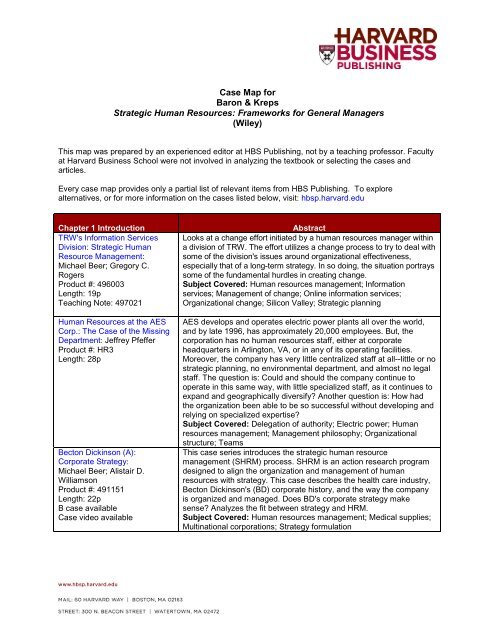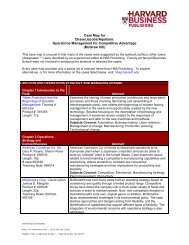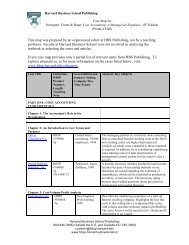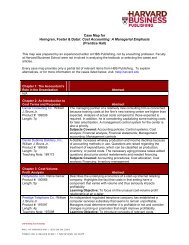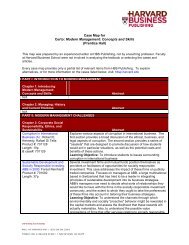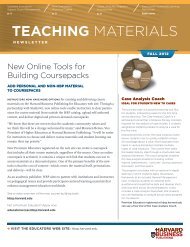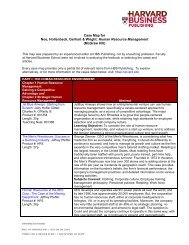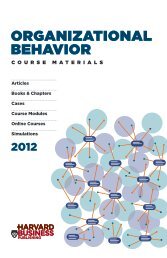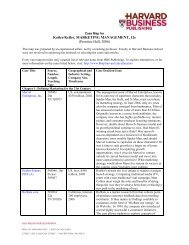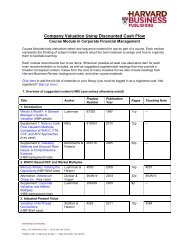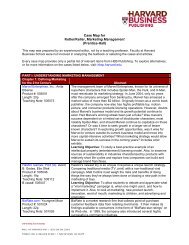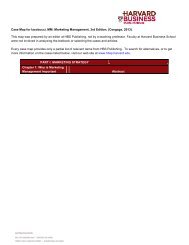Case Map for Baron & Kreps Strategic Human Resources - Harvard ...
Case Map for Baron & Kreps Strategic Human Resources - Harvard ...
Case Map for Baron & Kreps Strategic Human Resources - Harvard ...
Create successful ePaper yourself
Turn your PDF publications into a flip-book with our unique Google optimized e-Paper software.
<strong>Case</strong> <strong>Map</strong> <strong>for</strong><br />
<strong>Baron</strong> & <strong>Kreps</strong><br />
<strong>Strategic</strong> <strong>Human</strong> <strong>Resources</strong>: Frameworks <strong>for</strong> General Managers<br />
(Wiley)<br />
This map was prepared by an experienced editor at HBS Publishing, not by a teaching professor. Faculty<br />
at <strong>Harvard</strong> Business School were not involved in analyzing the textbook or selecting the cases and<br />
articles.<br />
Every case map provides only a partial list of relevant items from HBS Publishing. To explore<br />
alternatives, or <strong>for</strong> more in<strong>for</strong>mation on the cases listed below, visit: hbsp.harvard.edu<br />
Chapter 1 Introduction<br />
TRW's In<strong>for</strong>mation Services<br />
Division: <strong>Strategic</strong> <strong>Human</strong><br />
Resource Management:<br />
Michael Beer; Gregory C.<br />
Rogers<br />
Product #: 496003<br />
Length: 19p<br />
Teaching Note: 497021<br />
<strong>Human</strong> <strong>Resources</strong> at the AES<br />
Corp.: The <strong>Case</strong> of the Missing<br />
Department: Jeffrey Pfeffer<br />
Product #: HR3<br />
Length: 28p<br />
Becton Dickinson (A):<br />
Corporate Strategy:<br />
Michael Beer; Alistair D.<br />
Williamson<br />
Product #: 491151<br />
Length: 22p<br />
B case available<br />
<strong>Case</strong> video available<br />
Abstract<br />
Looks at a change ef<strong>for</strong>t initiated by a human resources manager within<br />
a division of TRW. The ef<strong>for</strong>t utilizes a change process to try to deal with<br />
some of the division's issues around organizational effectiveness,<br />
especially that of a long-term strategy. In so doing, the situation portrays<br />
some of the fundamental hurdles in creating change.<br />
Subject Covered: <strong>Human</strong> resources management; In<strong>for</strong>mation<br />
services; Management of change; Online in<strong>for</strong>mation services;<br />
Organizational change; Silicon Valley; <strong>Strategic</strong> planning<br />
AES develops and operates electric power plants all over the world,<br />
and by late 1996, has approximately 20,000 employees. But, the<br />
corporation has no human resources staff, either at corporate<br />
headquarters in Arlington, VA, or in any of its operating facilities.<br />
Moreover, the company has very little centralized staff at all--little or no<br />
strategic planning, no environmental department, and almost no legal<br />
staff. The question is: Could and should the company continue to<br />
operate in this same way, with little specialized staff, as it continues to<br />
expand and geographically diversify? Another question is: How had<br />
the organization been able to be so successful without developing and<br />
relying on specialized expertise?<br />
Subject Covered: Delegation of authority; Electric power; <strong>Human</strong><br />
resources management; Management philosophy; Organizational<br />
structure; Teams<br />
This case series introduces the strategic human resource<br />
management (SHRM) process. SHRM is an action research program<br />
designed to align the organization and management of human<br />
resources with strategy. This case describes the health care industry,<br />
Becton Dickinson's (BD) corporate history, and the way the company<br />
is organized and managed. Does BD's corporate strategy make<br />
sense? Analyzes the fit between strategy and HRM.<br />
Subject Covered: <strong>Human</strong> resources management; Medical supplies;<br />
Multinational corporations; Strategy <strong>for</strong>mulation
Chapter 2 The Five Factors<br />
IBM Corp., Background Note<br />
Richard F. Vancil; Arvind<br />
Bhambri; James Wilson<br />
Product #: 180034<br />
Length: 17p<br />
Teaching Note: 182230<br />
The Trans<strong>for</strong>mation of IBM:<br />
David B. Yoffie; Andrall E.<br />
Pearson<br />
Product #: 391073<br />
Length: 22p<br />
Teaching Note: 394036<br />
Supplement: 792105<br />
Chapter 3 Consistent HR<br />
Practices<br />
Morgan Stanley: Becoming a<br />
"One-Firm Firm": M. Diane<br />
Burton Thomas J. DeLong<br />
Katherine Lawrence<br />
Product #: 400043<br />
Length: 13p<br />
Teaching Note: 400078<br />
<strong>Human</strong> <strong>Resources</strong> at Hewlett-<br />
Packard (A): Michael Beer;<br />
Gregory C. Rogers<br />
Product #: 495051<br />
Length: 27p<br />
B case#: 495052<br />
Teaching Note: 497022<br />
Portman Hotel Co.: Charles C.<br />
Heckscher; Philip Holland<br />
Product #: 489104<br />
Length: 13p<br />
Teaching Note: 490085<br />
Abstract<br />
Describes some aspects of how the senior managers of IBM<br />
conducted its affairs. Much of this note is a factual description of the<br />
design of the organization and of the <strong>for</strong>mal process by which<br />
members of the organization worked together. Also contains excerpts<br />
from interviews with IBM executives describing their views of the<br />
corporation's managerial philosophy which guided their actions.<br />
Subject Covered: Computer industry; Management philosophy;<br />
Organizational design; Organizational structure<br />
John Akers, IBM's chairman, must confront how to trans<strong>for</strong>m a $60<br />
billion, full line, global computer company that is the leader in every<br />
market it serves, yet losing share across the board. The case explores<br />
senior management's perspective on the process of organization<br />
change.<br />
Subject Covered: Implementation; Organizational change;<br />
Organizational development; Strategy <strong>for</strong>mulation<br />
Abstract<br />
John Mack, the newly appointed president of Morgan Stanley, feels<br />
strongly that the firm needs to change in order to compete in a<br />
changing investment banking environment. This case describes the<br />
initiatives that Mack and his senior team undertake in order to<br />
trans<strong>for</strong>m the culture and working style of the firm from individualistic<br />
to team-oriented. Provides detailed in<strong>for</strong>mation about the existing<br />
culture and systems as well as the kinds of changes that the firm<br />
hopes to make. The case is an example of a firm that views the human<br />
resource management systems as a tool <strong>for</strong> attaining strategic<br />
objectives.<br />
Learning Objective: Intended to allow students to explore and<br />
evaluate the principles of strategic human resources management.<br />
Provides an overview of the human resource policies and practices<br />
applied by Hewlett-Packard (HP). Discusses HP's reactions as an<br />
organization to changes in its business environment. As such, it is an<br />
opportunity to analyze HP's practices, and how they have been<br />
affected through the years in all four policy areas: stakeholder<br />
influence, flows, rewards, and work systems.<br />
Subject Covered: High technology products; <strong>Human</strong> resources<br />
management; Management communication; Organizational behavior;<br />
Organizational change; Organizational management; Silicon Valley;<br />
Work <strong>for</strong>ce management<br />
A brand new hotel has opened with a new service strategy: import to<br />
America Asian-style service using a butler-like employee group called<br />
the personal valets. To achieve this high level of service, the hotel has<br />
paid great attention to its human resource policies, believing that the<br />
quality of its service will depend on the quality and motivation of the<br />
people, It articulates a series of employee "rights," which it tells<br />
employees are en<strong>for</strong>ceable in court. Upon opening employees are<br />
excited and highly motivated but soon morale and quality problems<br />
develop. The students must evaluate the hotel's human resource
United Parcel Service (A):<br />
Jeffrey A. Sonnenfeld; Meredith<br />
Lazo<br />
Product #: 488016<br />
Length: 22p<br />
B case#: 488017<br />
Teaching Note: 488011<br />
Chapter 4 Employment and<br />
Economics<br />
Sun Hydraulics Corp. (A): Louis<br />
B. Barnes; Colleen Kaftan<br />
Product #: 485169<br />
Length: 9p<br />
B case#: 485170<br />
C case#: 491125<br />
Teaching Note: 491015<br />
The SAS Institute: A Different<br />
Approach to Incentives and<br />
People Management Practices<br />
in the Software Industry: Jeffrey<br />
Pfeffer<br />
Product #: HR6<br />
Length: 17p<br />
management theory and practice in light of these problems.<br />
Subject Covered: Hotels & motels; <strong>Human</strong> resources management;<br />
Organization; Participatory management<br />
United Parcel Service (UPS) in 1987 faced serious challenges to its<br />
long-standing policies of on-the-job training and promotion from within.<br />
Increased competition in its traditional business of ground transport<br />
found UPS lagging in computerization and in need of technical<br />
expertise it could not simply cull from within its ranks. Whether, when,<br />
and how the new people were to be hired and assimilated, and to what<br />
extent the UPS culture and/or the new people would have to adapt,<br />
were the key questions.<br />
Subject Covered: Air freight service; Careers & career planning;<br />
Corporate culture; Diversification; Employee training; <strong>Human</strong><br />
resources management; Shipping<br />
Abstract<br />
Involves the design and creation of a company with no <strong>for</strong>mallydefined<br />
hierarchy. Describes the steps the founder takes to avoid the<br />
organizational politics he perceives as crushing the human<br />
contributions they were designed to harness.<br />
Subject Covered: Corporate culture; Employee attitude; Employee<br />
empowerment; Group dynamics; Management philosophy;<br />
Manufacturing; Teams<br />
The SAS Institute is a large, growing software company in the<br />
Research Triangle in North Carolina. Founded more than 25 years<br />
ago, it has evolved a unique approach, given its industry, to<br />
developing and retaining talent including using no stock options or<br />
phantom stock and not paying its salespeople on commission. The<br />
CEO and Vice President of <strong>Human</strong> <strong>Resources</strong> must decide how well<br />
their current management practices will continue to serve them as the<br />
company gains greater visibility and faces an increasingly competitive<br />
labor market.<br />
Subject Covered: Corporate culture; Employee compensation;<br />
<strong>Human</strong> resources management; Incentives; Management philosophy;<br />
Organizational behavior; Software
Chapter 5 Employment as a<br />
Social Relation<br />
United Parcel Service (A):<br />
Jeffrey A. Sonnenfeld; Meredith<br />
Lazo<br />
Product #: 488016<br />
Length: 22p<br />
B and C cases available<br />
Teaching Note: 488011<br />
Jensen Shoes: Jane Kravitz's<br />
Story: Mary Gentile Pamela J.<br />
Maus<br />
Product #: 395120<br />
Length: 7p<br />
Teaching Note: 396017<br />
Jensen Shoes: Lyndon<br />
Twitchell's Story: Mary Gentile<br />
Pamela J. Maus<br />
Product #: 395121<br />
Length: 8p<br />
Teaching Note: 396017<br />
Chapter 6 Voice: Unions and<br />
Other Forms<br />
Of Employee Representation<br />
Hitting the Wall: Nike and<br />
International Labor Practices:<br />
Debora Spar; Jennifer Burns<br />
Product #: 700047<br />
Length: 23p<br />
Teaching Note: 701020<br />
Abstract<br />
United Parcel Service (UPS) in 1987 faced serious challenges to its<br />
long-standing policies of on-the-job training and promotion from within.<br />
Increased competition in its traditional business of ground transport<br />
found UPS lagging in computerization and in need of technical<br />
expertise it could not simply cull from within its ranks. Whether, when,<br />
and how the new people were to be hired and assimilated, and to what<br />
extent the UPS culture and/or the new people would have to adapt,<br />
were the key questions.<br />
Subject Covered: Air freight service; Careers & career planning;<br />
Corporate culture; Diversification; Employee training; <strong>Human</strong><br />
resources management; Shipping<br />
Details the experiences of Jane Kravitz (Caucasian female), strategic<br />
product manager, and Lyndon Twitchell (African American male), a<br />
member of her staff at Jensen Shoes, a successful producer and<br />
marketer of casual, athletic, and children's footwear. They are<br />
assigned to new positions and to each other at the start of the story.<br />
Presents their very different points of view on their first couple of<br />
months working together.<br />
Learning Objective: Raises how stereotypes and self-fulfilling<br />
prophesies influence per<strong>for</strong>mance feedback. Can be taught in a<br />
variety of ways: with all students receiving both cases; half receiving<br />
one and half receiving the other; or a third of the class receiving both,<br />
one third receiving one, and one third receiving the other (as is<br />
appropriate). Should be used with Jensen Shoes: Lyndon Twitchell's<br />
Story (see below).<br />
Details the experiences of Jane Kravitz (Caucasian female), strategic<br />
product manager, and Lyndon Twitchell (African American male), a<br />
member of her staff at Jensen Shoes, a successful producer and<br />
marketer of casual, athletic, and children's footwear. They are<br />
assigned to new positions and to each other at the start of the story.<br />
Presents their very different points of view on their first couple of<br />
months working together.<br />
Learning Objective: Raises how stereotypes and self-fulfilling<br />
prophesies influence per<strong>for</strong>mance feedback. Can be taught in a<br />
variety of ways: with all students receiving both cases; half receiving<br />
one and half receiving the other; or a third of the class receiving both,<br />
one third receiving one, and one third receiving the other (as is<br />
appropriate). Should be used with Jensen Shoes: Jane Kravitz's Story<br />
(see above).<br />
Abstract<br />
In the mid-1990s Nike, one of the world's most successful footwear<br />
companies, is hit by a spate of alarmingly bad publicity. After years of<br />
high-profile media attention as the company that can "just do it," Nike<br />
is suddenly being painted as a firm that relies on low-cost, exploited<br />
labor in its overseas plants. Nike officials vigorously deny the charges,<br />
claiming that Nike has no control over the independent contractors<br />
who manufacture Nike shoes. But the activists will not retreat.
Sprint: La Conexion Familiar<br />
(A): Ann C. Frost; Daniel D.<br />
Campbell<br />
Product #: 97C001<br />
Length: 11p<br />
B case available<br />
Teaching Note: 897C01<br />
Slade Plating Department:<br />
Linda A. Hill<br />
Product #: 496018<br />
Length: 11p<br />
Haier Hefei Electronics Co. (A):<br />
Lynn Sharp Paine<br />
Product #: 308075<br />
Length: 25p<br />
B case available<br />
Air Traffic Controllers: Michael<br />
Beer; Bert A. Spector<br />
Product #: 482056<br />
Length: 27p<br />
Teaching Note: 485002<br />
Chapter 7 Employment,<br />
Society, and the Law<br />
Mitsubishi Motor Manufacturing<br />
of America: The Quest <strong>for</strong> a<br />
Model Workplace: Lynn Sharp<br />
Paine; Dale O. Coxe<br />
Eventually, Nike must learn to deal with the activists' claims and with<br />
the web of conflicting data that surrounds the notion of a "fair" or<br />
"living" wage.<br />
Learning Objective: To stimulate debate about appropriate wages in<br />
developing countries and the role of activists in affecting company<br />
decisions.<br />
Management at Sprint Corp. must decide what action to take with a<br />
small telemarketing operation that is about to vote on union<br />
representation. If employees vote in favor of a union, the operation<br />
would become the first business unit within Sprint Long Distance to be<br />
represented by a union. Closure of the plant is an option to be<br />
considered. This case illustrates some of the reasons employees seek<br />
union representation and requires that the student consider what<br />
implications such representation would have <strong>for</strong> the employer.<br />
Subject Covered: Communications industry; Labor unions;<br />
Unionization<br />
Describes a conflict between the values and norms of a segment of an<br />
internal social system and those of management and the wider culture.<br />
Includes decision opportunity. A rewritten version of an earlier case.<br />
Subject Covered: Conflict; Corporate culture; Employee<br />
compensation; Group dynamics; Labor relations; Metals; Personnel<br />
management; Teams<br />
The Haier Group, the first mainland Chinese company to make the<br />
Financial Times list of Asia's "most admired companies," attributes its<br />
success in large measure to the new value system it has sought to<br />
instill throughout the organization. However, when Haier takes over<br />
the Yellow Mountain television factory in the distant Hefei province at<br />
the behest of Hefei's government, workers strike against the Haier<br />
culture and what it stands <strong>for</strong>. The immediate catalyst is the contract<br />
Haier has asked them to sign. Haier's management must decide<br />
what's fair and how to respond to the workers' demands in the face of<br />
local government pressure to compromise.<br />
Learning Objective: To illustrate the challenges of trans<strong>for</strong>ming stateowned<br />
and collectively-owned Chinese enterprises into world-class<br />
competitors.<br />
On August 3, 1981 President Ronald Reagan terminated 12,000 air<br />
traffic controllers, members of the Professional Air Traffic Controllers<br />
Organization, <strong>for</strong> violating their no-strike oath. Provides background on<br />
the human resources policies and practices of the Federal Aviation<br />
System and in<strong>for</strong>mation concerning the negotiations and impact of the<br />
terminations.<br />
Subject Covered: Airlines; Collective bargaining; Federal<br />
government; Government agencies; <strong>Human</strong> resources management;<br />
Labor relations; Layoffs; Strikes<br />
Abstract<br />
Describes the sexual harassment case brought against Mitsubishi<br />
Motor Manufacturing of America by nearly 300 female employees in<br />
April 1996. Also presents the recommendations developed <strong>for</strong> the<br />
company by <strong>for</strong>mer U.S. Labor Secretary Lynn Marten. In response to
Product #: 398028<br />
Length: 8p<br />
Star Distributors, Inc. (A): David<br />
A. Thomas; Deborah J. Evans<br />
Product #: 493015<br />
Length: 16p<br />
B case available<br />
Teaching Note: 496004<br />
Ann Hopkins (A) Joseph L.<br />
Badaracco Jr.; Ilyse Barkan<br />
Product #: 391155<br />
Length: 28p<br />
B case available<br />
Teaching Note: 392145<br />
Workplace Safety at Alcoa (A)<br />
Kim B. Clark; Joshua D.<br />
Margolis<br />
Product #: 692042<br />
Length: 22p<br />
B case available<br />
Teaching Note: 697128<br />
Chapter 8 Internal Labor<br />
Markets<br />
United Parcel Service (A):<br />
Jeffrey A. Sonnenfeld; Meredith<br />
Lazo<br />
Length: 22p<br />
Product #: 488016<br />
B and C cases available<br />
Teaching Note: 488011<br />
the harassment controversy, Marten was asked to review the plant's<br />
policies and to <strong>for</strong>mulate a plan <strong>for</strong> a "model workplace."<br />
Learning Objective: To help students develop an understanding of<br />
the causes and consequences of sexual harassment, and to illustrate<br />
an approach to developing a harassment-free environment.<br />
Depicts the conflict and organizational problems that emerged in a<br />
franchise operation owned by Paul Logan, an African American, and<br />
John Heyman, a white American. Provides the opportunity to examine<br />
the ways in which race influences managerial behavior and<br />
organizational dynamics. Also raises issues of organizational<br />
per<strong>for</strong>mance, headquarters-franchise relations and conflict resolution.<br />
Subject Covered: Discrimination; Diversity; Franchising; Interpersonal<br />
behavior; Managerial behavior; Organizational behavior<br />
Intended to help students understand the many barriers organizations<br />
face as their members and their management ranks grow more<br />
diverse. As a case on business ethics, it encourages students to<br />
discuss what "fairness" and "diversity" mean when an organization is<br />
also trying to create a sense of teamwork and "fit." Based upon the<br />
open court records of Ann Hopkins versus Price Waterhouse, a sexual<br />
discrimination and sexual stereotyping suit brought by a woman who<br />
was denied partnership at Price Waterhouse. (The court found in her<br />
favor.) Includes lengthy exhibits drawn directly from Price Waterhouse.<br />
Subject Covered: Discrimination; Diversity; Ethics; Legal aspects of<br />
business; Women<br />
Examines the challenge facing the managers of a large aluminum<br />
manufacturing plant in its drive to improve workplace safety. The CEO<br />
of the company has made safety a top priority. The plant has made<br />
good progress in reducing the injury rate, but now confronts the need<br />
to accelerate its improvement. Doing so requires the safety director to<br />
consider progress to date and analyze the opportunities <strong>for</strong><br />
improvement, many of which involve fundamental changes in behavior<br />
at all levels of the organization. Designed to introduce students to the<br />
issues of safety in its operating context. Students have in<strong>for</strong>mation<br />
available that allows them to analyze underlying causes and identify<br />
major opportunities <strong>for</strong> improvement. However, the interactions<br />
between safety and other dimensions of manufacturing per<strong>for</strong>mance<br />
are evident in developing and implementing a plan <strong>for</strong> improvement.<br />
Subject Covered: Aluminum industry; Manufacturing strategy;<br />
Occupational safety; Operating systems; Operations management;<br />
Terminations<br />
Abstract<br />
United Parcel Service (UPS) in 1987 faced serious challenges to its<br />
long-standing policies of on-the-job training and promotion from within.<br />
Increased competition in its traditional business of ground transport<br />
found UPS lagging in computerization and in need of technical<br />
expertise it could not simply cull from within its ranks. Whether, when,<br />
and how the new people were to be hired and assimilated, and to what<br />
extent the UPS culture and/or the new people would have to adapt,<br />
were the key questions.
Chapter 9 High-Commitment<br />
HR<br />
Note on High-Commitment<br />
Work Systems: David A. Garvin<br />
Norman Klein<br />
Product #: 693080<br />
Length: 10p<br />
Vancom Transportation, Inc.<br />
(A): Louis B. Barnes<br />
Product #: 494127<br />
Length: 13p<br />
B case available<br />
Measure of Delight: The Pursuit<br />
of Quality at AT&T Universal<br />
Card Services (A): Roy D.<br />
Shapiro; Michael D. Watkins;<br />
Susan Rosegrant<br />
Product #: 694047<br />
Length: 23p<br />
Teaching Note: 696073<br />
B case available<br />
PPG: Developing a Self-<br />
Directed Work Force (A): David<br />
A. Garvin Norman Klein<br />
Product #: 693020<br />
Length: 18p<br />
B and C cases available<br />
Teaching Note: 697095<br />
Chapter 10 Per<strong>for</strong>mance<br />
Evaluation<br />
The Firmwide 360-degree<br />
Per<strong>for</strong>mance Evaluation<br />
Process at Morgan: Stanley M.<br />
Diane Burton<br />
Product #: 498053<br />
Subject Covered: Air freight service; Careers & career planning;<br />
Corporate culture; Diversification; Employee training; <strong>Human</strong><br />
resources management; Shipping<br />
Abstract<br />
Describes the history, theory, and practice of high-commitment work<br />
systems. The history reviews classical approaches (i.e. Frederick<br />
Taylor), the human relations movement, the human resources<br />
approach, quality of work life, and empowerment. The theory<br />
examines the underlying principles of design. The practice section<br />
reviews the experiences to date with these systems, including such<br />
innovations as gainsharing and such problems as defining the role of<br />
supervisor.<br />
Subject Covered: Employee empowerment; Job satisfaction;<br />
Operations management; Teams; Work <strong>for</strong>ce management<br />
Describes the history and evolution of a school/public bus transit<br />
company that has grown rapidly and successfully by (gradually)<br />
pushing responsibility and trust as far down the organization as<br />
possible. A real test comes however, in two major labor relations<br />
issues.<br />
Learning Objective: To show how an avant garde philosophy must<br />
still meet constant challenges which pose new dilemmas and tests.<br />
AT&T's Universal Card Services (UCS) has been extremely successful<br />
during its short lifetime. Dedicated to improving service quality and<br />
customer satisfaction, Chief Quality Officer Rob Davis and his Quality<br />
Team have designed and put into place an unusual measurement and<br />
compensation system based on more than 100 per<strong>for</strong>mance<br />
measures monitored and communicated daily.<br />
Learning Objective: Links per<strong>for</strong>mance measurement and<br />
compensation policies to precepts of quality management.<br />
PPG has built a state-of-the-art glass plant in Berea, Kentucky. The<br />
plant is pursuing the goal of a "self-directed work<strong>for</strong>ce." The case<br />
describes the progress to date and the unresolved issues faced by<br />
management. These include questions about shift rotation, promotion<br />
opportunities, employee evaluation and supervision, the role of<br />
employees in policy setting, and whether or not to introduce a system<br />
of peer review. Explores the process of creating a self-directed<br />
work<strong>for</strong>ce, the underlying theoretical model, and the difficulties and<br />
tensions inherent in that approach.<br />
Subject Covered: Employee empowerment; Glassware industry;<br />
<strong>Human</strong> resources management; Work <strong>for</strong>ce management<br />
Abstract<br />
Describes Morgan Stanley's firmwide, 360-degree per<strong>for</strong>mance<br />
evaluation process. Evaluation <strong>for</strong>ms are included as exhibits.<br />
Learning Objective: To introduce students to a 360-degree<br />
per<strong>for</strong>mance evaluation process.
Length: 16p<br />
B case#: 498054<br />
Teaching Note: 400078<br />
Verizon Communications, Inc.:<br />
Implementing a <strong>Human</strong><br />
<strong>Resources</strong> Balanced<br />
Scorecard: Srikant M. Datar<br />
Marc J. Epstein Jeremy Cott<br />
Product #: 101102<br />
Length: 23p<br />
AvantGo: Alan MacCormack;<br />
Kerry Herman<br />
Product #: 601095<br />
Length: 19p<br />
Conducting a Per<strong>for</strong>mance<br />
Appraisal Interview<br />
(HBS background note):<br />
Michael Beer<br />
Product #: 497058<br />
Length: 16p<br />
In early 2000, Verizon Communications implemented a <strong>Human</strong><br />
<strong>Resources</strong> Balanced Scorecard to evaluate the effectiveness of and<br />
payoffs from human resource management. This case describes the<br />
benefits of the scorecard and the challenges of measurement and<br />
implementation.<br />
Learning Objective: To help students understand: 1) how to<br />
implement a Balanced Scorecard, 2) how to measure and improve the<br />
effectiveness of support functions, and 3) how to link nonfinancial<br />
measures to financial measures of support functions when financial<br />
benefits are difficult to quantify.<br />
Richard Owen, CEO of AvantGo, is preparing <strong>for</strong> a meeting in which<br />
he will set the human resource policy <strong>for</strong> the firm going <strong>for</strong>ward. It has<br />
been three months since the company's IPO, and given the<br />
tremendous cramp in hiring over the six months prior to the IPO, he<br />
knows that this meeting will set the expectations <strong>for</strong> the many annual<br />
evaluations that will follow. Uppermost in his mind is the decision over<br />
whether to implement a "<strong>for</strong>ced-curve" grading scheme, and the<br />
implications of this decision on staff perceptions and notification.<br />
Learning Objective: To illustrate the challenges of a rapidly growing<br />
new technology venture, specifically with regard to the hiring,<br />
retention, and firing of new employees. Also examines the process of<br />
building a senior management team, including the decision of when to<br />
replace a CEO, how to do it, and with whom.<br />
Discusses typical problems experienced by managers in conducting<br />
per<strong>for</strong>mance appraisal interviews. The underlying causes of these<br />
problems are analyzed and ideas are presented that might help<br />
managers overcome these problems. A rewritten version of an earlier<br />
note.<br />
Subject Covered: Employee promotions; Per<strong>for</strong>mance appraisal;<br />
Personnel management; Superior & subordinate
Chapter 11 Pay <strong>for</strong><br />
Per<strong>for</strong>mance<br />
And<br />
Chapter 12 Compensation<br />
Systems: Forms, Bases, and<br />
Distribution of Rewards<br />
Belmont Industries, Inc. (A):<br />
Joseph L. Bower<br />
Product #: 301016<br />
Length: 3p<br />
Teaching Note: 398180<br />
Doyle's Dealmaking Dilemma:<br />
Negotiating the Job Search:<br />
James K. Sebenius<br />
Product #: 800124<br />
Length: 12p<br />
Nordstrom: Dissension in the<br />
Ranks? (A): Robert L. Simons<br />
Hilary A. Weston<br />
Product #: 191002<br />
Length: 24p<br />
Teaching Note: 192026<br />
B case available<br />
Au Bon Pain: The French<br />
Bakery Cafe, the<br />
Partner/Manager Program: W.<br />
Earl Sasser Jr.; Lucy N. Lytle<br />
Product #: 687063<br />
Length: 24p<br />
Teaching Note: 692090<br />
Note on Employee Stock<br />
Ownership Plans (ESOPs) and<br />
Phantom Stock Plans:<br />
Dwight B. Crane Indra A.<br />
Reinbergs<br />
Abstract<br />
A new general manager has to propose a salary structure <strong>for</strong> the top<br />
20 managers. His task is complicated as he learns about past<br />
per<strong>for</strong>mance, ambitions, interpersonal relations, and market<br />
conditions.<br />
Learning Objective: To introduce compensation issues from a<br />
general management perspective as opposed to a functional human<br />
resources perspective. A rewritten version of an earlier case.<br />
MBA student Doyle Williams searches <strong>for</strong> his ideal job in a private<br />
equity group and uses his negotiation skills to try to attain the best<br />
possible compensation package.<br />
Learning Objective: Assisting MBAs to understand and manage the<br />
job selection and salary negotiation process.<br />
In 1989, the per<strong>for</strong>mance measurement systems and compensation<br />
policies of Nordstrom Department Stores unexpectedly came under<br />
attack by employees, unions, and government regulators. The case<br />
describes the "sales-per-hour" monitoring and compensation system<br />
that many believed to be instrumental in Nordstrom's phenomenal<br />
success. Illustrates how rapid company growth, decentralized<br />
management, and unrelenting pressure to per<strong>for</strong>m can distort<br />
per<strong>for</strong>mance measurement systems and lead to undesirable<br />
consequences.<br />
Subject Covered: Control systems; Employee compensation; Goal<br />
setting; Motivation; Per<strong>for</strong>mance measurement; Retailing<br />
In recent years, Au Bon Pain (ABP), a chain of sandwich cafes,<br />
confronted a set of human resource problems endemic to the fast food<br />
industry: a labor shortage, an inadequately trained management staff,<br />
and high turnover). To deal with the resulting "cycle of failure" while<br />
increasing individual initiative and per<strong>for</strong>mance at the unit level, ABP<br />
devised a new compensation-incentive system <strong>for</strong> its store managersthe<br />
Partner/Manager Program. Under this program, store managers<br />
would be paid a standard base salary plus a share of the incremental<br />
profits. The case asks students to evaluate the program by comparing<br />
it to ABP's existing compensation system, determining the different<br />
ways in which managers from two stores operating under an<br />
experimental run of the program achieved their results. Students are<br />
also asked to consider the strategic implications of implementing the<br />
program in all of the company's stores.<br />
Subject Covered: Executive compensation; Fast food industry;<br />
<strong>Human</strong> resources management; Middle management; Restaurants;<br />
Services<br />
Provides a brief overview of employee stock ownership plans (ESOPs)<br />
and phantom stock plans <strong>for</strong> owners of closely held companies.<br />
ESOPs can be used as a tool of corporate financing, and can provide<br />
employees with ownership interests. Phantom stock plans can reward<br />
executives <strong>for</strong> value creation without giving up ownership. Covers
Product #: 201034<br />
Length: 8p<br />
Yahoo!'s Stock-Based<br />
Compensation: Paul M. Healy;<br />
Jacob Cohen<br />
Product #: 101059<br />
Length: 8p<br />
Verizon Communications, Inc.:<br />
Implementing a <strong>Human</strong><br />
<strong>Resources</strong> Balanced<br />
Scorecard: Srikant M. Datar<br />
Marc J. Epstein Jeremy Cott<br />
Product #: 101102<br />
Length: 23p<br />
Mary Kay Cosmetics, Inc.:<br />
Sales Force Incentives (A):<br />
Robert L. Simons Hilary A.<br />
Weston<br />
Product #: 190103<br />
Length: 16p<br />
Teaching Note: 191198<br />
B case available<br />
Navistar International: Stuart C.<br />
Gilson; Jeremy Cott<br />
Product #: 295030<br />
Length: 23p<br />
Teaching Note: 298086<br />
typical company motives <strong>for</strong> establishing such plans, regulation, tax<br />
advantages, administrative costs, issues of corporate governance, and<br />
payment of plan benefit. Includes a two-page bibliography with<br />
references to further sources of legal and tax in<strong>for</strong>mation.<br />
Subject Covered: Employee benefits; ESOP; Executive<br />
compensation; Financing; Securities; Small business; Succession<br />
planning<br />
Amy Maislos, an investor in Internet and technology companies, was<br />
excited to read that Yahoo! had reported a positive net income <strong>for</strong><br />
1998 operations. During the late 1990s, stock prices of Internet<br />
companies had risen rapidly even though most companies were<br />
reporting losses. Amy believed that investors and Wall Street analysts<br />
would soon expect profits from tech companies. When she reviewed<br />
the annual report she noticed a compensation footnote that reported<br />
that if Yahoo! had booked an expense <strong>for</strong> stock options, the company<br />
would have had a loss <strong>for</strong> 1998 operations.<br />
Learning Objective: To discuss the accounting treatments of stock<br />
options, the controversy surrounding the topic, and to understand<br />
financial footnote disclosure.<br />
In early 2000, Verizon Communications implemented a <strong>Human</strong><br />
<strong>Resources</strong> Balanced Scorecard to evaluate the effectiveness of and<br />
payoffs from human resource management. This case describes the<br />
benefits of the scorecard and the challenges of measurement and<br />
implementation.<br />
Learning Objective: To help students understand: 1) how to<br />
implement a Balanced Scorecard, 2) how to measure and improve the<br />
effectiveness of support functions, and 3) how to link nonfinancial<br />
measures to financial measures of support functions when financial<br />
benefits are difficult to quantify.<br />
Describes the incentive system by which Mary Kay Cosmetics<br />
motivates the sales <strong>for</strong>ce of 200,000 independent agents who<br />
comprise the firm's only distribution channel. Illustrates the powerful<br />
effect on sales-<strong>for</strong>ce behavior that results when creative types of<br />
employee recognition are combined with financial incentives. Focuses<br />
on the challenges that managers face when they try to reduce<br />
program costs by modifying the VIP automobile program that awards<br />
the use of pink Cadillacs and other cars to successful sales agents. A<br />
detailed description of the parameters and <strong>for</strong>mulas that drive the<br />
recognition and reward programs is provided.<br />
Subject Covered: Control systems; Cosmetics; Goal setting;<br />
Incentives; Motivation; Sales compensation; Sales management<br />
As a consequence of laying off half its work<strong>for</strong>ce in a massive<br />
downsizing program, the company--a large manufacturer of medium<br />
and heavy trucks--struggles with a huge ($2.6 billion) liability <strong>for</strong> retiree<br />
medical costs. Although the company has promised its retirees (and<br />
their families) full lifetime medical coverage, it must negotiate a<br />
substantial reduction in these benefits to avoid possible bankruptcy.<br />
Learning Objective: Highlights the approaches a company can take<br />
to restructure its retiree medical liabilities--an increasingly important<br />
problem facing a growing number of U.S. corporations. Also provides<br />
a vehicle <strong>for</strong> discussing possible negotiating strategies a company can
Jim Sawyer (A): Kenneth E.<br />
Goodpaster; Dekkers L.<br />
Davidson<br />
Product #: 383029<br />
Length: 7p<br />
Teaching Notes: 383126,<br />
392144<br />
B case available<br />
Note on Managed Care:<br />
Richard Bohmer<br />
Product #: 698060<br />
Length: 16p<br />
Chapter 13 Job Design<br />
The Ritz-Carlton Hotel<br />
Company: Sandra Sucher;<br />
Stacy McManus<br />
Product #: 601163<br />
Length: 31p<br />
Teaching Note: 602113<br />
The SAS Institute: A Different<br />
Approach to Incentives and<br />
People Management Practices<br />
in the Software Industry:<br />
Jeffrey Pfeffer<br />
Product #: HR6<br />
Length: 17p<br />
Jack Stack (A): Kirk O. Hanson;<br />
David Bollier<br />
Product #: 993009<br />
Teaching Note: 993013<br />
B case#: 993010<br />
adopt when seeking concessions from organized labor.<br />
Jim Sawyer, 40, a manager at United Industries Plastics Division has<br />
exhibited signs of alcoholism. Personnel must now consider how the<br />
company should address this kind of problem. Provides an opportunity<br />
to examine the role corporations should play in helping employees<br />
deal with or confront issues of personal health.<br />
Subject Covered: Corporate responsibility; Employee attitude;<br />
Employee benefits; Health; <strong>Human</strong> resources management; Personnel<br />
policies<br />
Presents an overview of managed care. Describes the relationship<br />
between provider and insurance companies, examines the<br />
implications <strong>for</strong> consumers, and discusses financial arrangements and<br />
operational characteristics commonly observed in the industry.<br />
Subject Covered: Health care; Health insurance; Health<br />
organizations management; Managed care; Service management<br />
Abstract<br />
In just seven days, The Ritz-Carlton trans<strong>for</strong>ms newly hired employees<br />
into "Ladies and Gentlemen Serving Ladies and Gentlemen." The<br />
case details a new hotel launch, focusing on the unique blend of<br />
leadership, quality processes, and values of self-respect and dignity,<br />
to create award-winning service.<br />
Learning Objective: Allows students to examine innovation and<br />
improvement in a service industry. Raises questions of when and how<br />
to innovate in a successful service operating system and the<br />
challenges of innovation <strong>for</strong> a brand built on customer experience.<br />
Teaching points include the role of leadership and values in creating a<br />
culture of service and the need to manage the tension between<br />
standardized quality procedures and the cultivation of empowered<br />
employees who can customize each interaction to meet the needs of<br />
their customers.<br />
The SAS Institute is a large, growing software company in the<br />
Research Triangle in North Carolina. Founded more than 25 years<br />
ago, it has evolved a unique approach, given its industry, to<br />
developing and retaining talent including using no stock options or<br />
phantom stock and not paying its salespeople on commission. The<br />
CEO and Vice President of <strong>Human</strong> <strong>Resources</strong> must decide how well<br />
their current management practices will continue to serve them as the<br />
company gains greater visibility and faces an increasingly competitive<br />
labor market.<br />
Subject Covered: Corporate culture; Employee compensation;<br />
<strong>Human</strong> resources management; Incentives; Management philosophy;<br />
Organizational behavior; Software<br />
Describes Jack Stack's ef<strong>for</strong>ts to revive a diesel engine<br />
remanufacturing plant owned by International Harvester. Stack<br />
engineers a leveraged buyout of the factory by its managers. He then<br />
implements a radical system <strong>for</strong> managing the company, through<br />
which every employee is trained to read complete financial reports of<br />
the company and given weekly operating data. In this way, they can
MacTemps: Building<br />
Commitment in the Interim<br />
Work<strong>for</strong>ce: Jeffrey L. Bradach<br />
Nicole Sackley<br />
Product #: 497005<br />
Length: 20p<br />
Teaching Note: 497065<br />
Chapter 14 Staffing and<br />
Recruitment<br />
Recruiting at Bowles Hollowell<br />
Conner & Co.: Herminia Ibarra;<br />
John P. Kotter; John J.<br />
Gabarro; Andrew Burtis<br />
Product #: 494071<br />
Length: 27p<br />
Pathways to Independence:<br />
Welfare-to-Work at Marriott<br />
International: Rosabeth Moss<br />
Kanter; Ellen Pruyne<br />
Product #: 399067<br />
Length: 20p<br />
Bitstream: Michael J. Roberts<br />
Product #: 393055<br />
Length: 15p<br />
Teaching Note: 898255<br />
see in detail how the company is progressing.<br />
Learning Objective: May be used in <strong>Human</strong> <strong>Resources</strong>,<br />
Organizational Behavior, <strong>Strategic</strong> Management, and<br />
Entrepreneurship courses to help students explore: 1) worker<br />
empowerment and related human resources issues; 2) the impact of<br />
the disclosure of company data on corporate strategy; 3) how an<br />
entrepreneur engineers a leveraged buyout; 4) the revitalization of<br />
"rust-belt" facilities; and 5) the role of worker empowerment in<br />
entrepreneurship.<br />
MacTemps provides temporary workers skilled in computer graphics<br />
and database management. Unlike many temporary agencies that<br />
treat temps as a commodity, MacTemps has attempted to build<br />
relationships with temps through offering benefits and training. This<br />
case explores the pros and cons of this strategy by presenting data on<br />
the underlying economics of the arrangement and the characteristics<br />
of the temp <strong>for</strong>ce.<br />
Learning Objective: To discuss the economics of contingent work<br />
arrangements, strategies <strong>for</strong> building relationships with workers/temps,<br />
strategies <strong>for</strong> staffing firms in highly competitive environments, and the<br />
changing social contract between people and organizations.<br />
Abstract<br />
Examines the recruiting process of Bowles Hollowell Conner & Co.<br />
(BHC), an investment banking firm known <strong>for</strong> its work with middle<br />
market companies. Specifically, presents a profile of the firm and its<br />
recruiting process and then examines that process through the firm's<br />
recruiting ef<strong>for</strong>ts at <strong>Harvard</strong> Business School (HBS). Includes the<br />
resumes of 17 second-year HBS students who sought interviews <strong>for</strong><br />
an associate position with BHC and raises the issue of how interview<br />
selections were made from those resumes.<br />
Subject Covered: <strong>Human</strong> resources management; Personnel<br />
selection; Recruitment<br />
In 1991 Marriott International established a program called Pathways<br />
to Independence to recruit and train people from the welfare rolls. The<br />
program graduated over 1,000 people in eight years and retained<br />
about 20% more of its participants than regular hires. Now the<br />
program director wished to double the program size. The questions:<br />
Was this feasible with a decreasing supply of employable welfare<br />
recipients? Could the quality control required at Marriott be maintained<br />
with such a large and rapid expansion?<br />
Subject Covered: Control systems; Employee training; Innovation;<br />
Leadership; Recruitment; Service management; Social change; Social<br />
enterprise; Work <strong>for</strong>ce management<br />
Focuses on the new CEO of a growing software firm, the culture he's<br />
tried to create, and the need to hire a manager to spearhead a new<br />
product division. Includes details on how the search was conducted<br />
and presents resumes of four candidates who are being considered <strong>for</strong><br />
the position. Designed to allow students to think through the<br />
recruitment, selection, and interview process.<br />
Subject Covered: Personnel selection; Recruitment; Software
Note on the Hiring and<br />
Selection Process: Michael J.<br />
Roberts<br />
Product #: 393093<br />
Length: 14p<br />
DigitalThink: Building a Sales<br />
Force: Michael J. Roberts;<br />
Joseph B. Lassiter III; Christina<br />
Darwall<br />
Product #: 898193<br />
Length: 32p<br />
Chapter 15 Training<br />
The Ritz-Carlton Hotel<br />
Company: Sandra Sucher;<br />
Stacy McManus<br />
Product #: 601163<br />
Length: 31p<br />
Teaching Note: 602113<br />
Chaparral Steel: Rapid Product<br />
and Process Development:<br />
Dorothy Leonard-Barton; Gil<br />
Preuss<br />
Product #: 692018<br />
Length: 17p<br />
Teaching Note: 692047<br />
SUPERVALU, Inc.: Professional<br />
Development Program: Francis<br />
J. Aguilar<br />
Product #: 900019<br />
Length: 21p<br />
Teaching Note: 692047<br />
Motorola (A): Kathleen Meyer;<br />
Matt Kelemen; Stephanie Weiss<br />
Product #: 996051<br />
Length: 4p<br />
Teaching Note: 996053<br />
Describes a model <strong>for</strong> thinking about the hiring and selection process.<br />
Subject Covered: Entrepreneurial management; Growth<br />
management; Personnel management; Personnel selection;<br />
Recruitment<br />
Describes the broad set of issues faced by a young company in the<br />
Internet-based training business as they begin to sell their product to<br />
corporate customers. Issues include: profile of attractive candidates,<br />
compensation, definition of territory, definition of quotas, and role of<br />
regional management.<br />
Learning Objective: To explore the detailed decisions and<br />
implementation steps required to build a sales <strong>for</strong>ce.<br />
Abstract<br />
In just seven days, The Ritz-Carlton trans<strong>for</strong>ms newly hired employees<br />
into "Ladies and Gentlemen Serving Ladies and Gentlemen." The<br />
case details a new hotel launch, focusing on the unique blend of<br />
leadership, quality processes, and values of self-respect and dignity,<br />
to create award-winning service.<br />
Learning Objective: Allows students to examine innovation and<br />
improvement in a service industry. Raises questions of when and how<br />
to innovate in a successful service operating system and the<br />
challenges of innovation <strong>for</strong> a brand built on customer experience.<br />
Teaching points include the role of leadership and values in creating a<br />
culture of service and the need to manage the tension between<br />
standardized quality procedures and the cultivation of empowered<br />
employees who can customize each interaction to meet the needs of<br />
their customers.<br />
One of the nation's <strong>for</strong>emost mini-mills' core competence is the rapid<br />
realization of technology into products. This case describes the<br />
development of a highly innovative casting technique and features the<br />
role of the company's culture in achieving its goals. The company<br />
exemplifies a learning organization.<br />
Subject Covered: Corporate culture; Innovation; Product<br />
development; Production planning; Research & development; Steel;<br />
Technology<br />
SUPERVALU examines the creation and implementation of a training<br />
program <strong>for</strong> attracting and retaining college graduates <strong>for</strong> the nation's<br />
largest wholesale food distribution company. It addresses: 1) program<br />
design and 2) the management of the design ef<strong>for</strong>t and program<br />
implementation. The case is appropriate <strong>for</strong> courses in organizational<br />
behavior, human resources management, and general management.<br />
Learning Objective: To learn how to manage the creation,<br />
introduction, and perpetuation of a complex training program in a<br />
large, dynamic business organization with a strong culture.<br />
In the late 1970s, Motorola CEO Bob Galvin knew that the electronics<br />
industry was growing increasingly competitive. Though Motorola was<br />
faring well in the battle, technology was sprinting ahead. In fact, most<br />
technical knowledge was obsolete within a five-year time frame. In an<br />
attempt to embrace the change, Galvin proposed to his board of
Supplements available<br />
Bidwell Training Center, Inc.<br />
and Manchester Craftsmen's<br />
Guild: Preparation in Pittsburgh:<br />
James L. Heskett Roger<br />
Hallowell<br />
Product #: 693087<br />
Length: 22p<br />
Sealed Air Taiwan (A): Lynn<br />
Sharp Paine; Robert J.<br />
Craw<strong>for</strong>d<br />
Product #: 399058<br />
Length: 21p<br />
B case available<br />
Managing: Conflict in a Diverse<br />
Workplace: Mary Gentile; Sara<br />
B. Gant<br />
Product #: 395090<br />
Length: 25p<br />
Teaching Note: 396008<br />
Chapter 16 Promotion and<br />
Career Concerns<br />
Yvette Hyater-Adams and Terry<br />
Larsen at CoreState Financial<br />
Corp.: David A. Thomas; Emily<br />
D. Heaphy; Nancie Zane<br />
Product #: 401023<br />
Length: 5p<br />
Managing Your Career<br />
(HBS background note): Linda<br />
directors an extraordinary commitment to the training of Motorola's<br />
entire work<strong>for</strong>ce--from executives to shop floor employees. He was<br />
met with strong resistance, however, due to the time and financial<br />
resources such training would require. Galvin was faced with a<br />
dilemma: if he accepted the board's counsel, the company might fall<br />
behind as the velocity of technological change increased; if he pushed<br />
<strong>for</strong> the investment in training, he might jeopardize short-term<br />
per<strong>for</strong>mance and competitive position.<br />
Learning Objective: Allows students to think strategically about the<br />
struggle of maintaining a competitive edge in a fast-changing industry<br />
and to discuss the real-life benefits that can result from investing in<br />
employees.<br />
Bill Strickland, executive director of both Bidwell Training Center and<br />
Manchester Craftsmen's Guild, has built a highly successful training<br />
organization to enable underprivileged minorities in Pittsburgh to<br />
escape the cycle of poverty. His success has led to questions of<br />
expansion, focus, and core competencies.<br />
Learning Objective: Strong vehicle <strong>for</strong> a discussion of the role<br />
training can play in organizations and the attitudes toward training<br />
necessary to maximize its effectiveness.<br />
The general manager <strong>for</strong> U.S.-based Sealed Air Corp.'s Taiwan<br />
subsidiary must decide whether he's hired the right person to bridge<br />
the gap between Sealed Air's corporate culture and Taiwan's business<br />
culture. This case details Bob Kayser's experiences in trying to infuse<br />
the Sealed Air culture into the Taiwan operation, including approaches<br />
to training, compensation, and motivation.<br />
Learning Objective: To help students understand important aspects<br />
of Chinese culture in Taiwan and to explore approaches to bridging<br />
gaps between differing cultures.<br />
Consists of several vignettes and discussion points around issues of<br />
conflict in the workplace. Issues presented are differences of race,<br />
gender, nationality, culture, religion; access to power, training,<br />
advancement; tolerance of style of management, language, politics;<br />
implications of involvement in these issues.<br />
Subject Covered: Conflict; Cross cultural relations; Grievances;<br />
Group behavior; Job satisfaction; Work <strong>for</strong>ce management<br />
Abstract<br />
Yvette Hyater-Adams, senior VP of CoreStates Bank, and CEO Terry<br />
Larsen reflect on their five-year mentor-protege relationship. They<br />
describe how building a relationship across both race and gender was<br />
challenging and ultimately highly rewarding. Their relationship develops in<br />
the context of a major culture change that Hyater-Adams and Larsen<br />
were leading the organization through. This case discusses how their<br />
relationship impacted the organization and the change process.<br />
Learning Objective: Allows students to develop a deep appreciation <strong>for</strong><br />
the initiation and development of mentoring relationships. Also explores<br />
the dynamics of cross-race and cross-gender work relationships.<br />
Describes the way in which managers learn and develop through onthe-job<br />
experience. Outlines a model <strong>for</strong> launching a "success
A. Hill<br />
Product #: 494082<br />
Length: 14p<br />
Chapter 17 Downsizing<br />
British Petroleum (A1):<br />
Organizing <strong>for</strong> Per<strong>for</strong>mance at<br />
BPX: Joel Podolny; John<br />
Roberts<br />
Product #: IB16A1<br />
Length: 17p<br />
Bradley Marquez: Reduction in<br />
Force (A): Thomas J. DeLong;<br />
Vineeta Vijayaraghavan<br />
Product #: 403005<br />
Length: 8p<br />
Teaching Note: 407091<br />
B case available<br />
Dreyer's Grand Ice Cream (A):<br />
Glenn R. Carroll Jennifer<br />
Chatman Victoria Chang<br />
Product #: OB35A<br />
Length: 25p<br />
B case#: OB35B<br />
Chapter 18 Outsourcing<br />
Exercise:<br />
Selecting a Hosting Provider:<br />
Robert D. Austin<br />
Product #: 601171<br />
Length: 12p<br />
Teaching Note: 602074<br />
syndrome" by building power and influence over the course of one's<br />
career. Also identifies some of the special challenges of: 1) managing<br />
one's early career, 2) developing power as a minority in the<br />
organization and the "glass ceiling" phenomenon, and 3) developing<br />
ethical judgment. Focusing special attention on the importance of selfassessment<br />
and introspection in building a successful career, the note<br />
concludes with a list of questions individuals should ask themselves<br />
periodically to take stock of their career and personal development.<br />
Subject Covered: Careers & career planning; Interpersonal relations;<br />
Management development; Managerial skills; Organizational behavior;<br />
Power & influence<br />
Abstract<br />
In 1992-93, British Petroleum plc, Britain's fourth-largest of the great<br />
international integrated oil companies, faced a major crisis. The<br />
company was experiencing its first losses in its eighty-year history,<br />
while morale was battered by downsizing and organizational upheaval.<br />
Subject Covered: Competition; Downsizing; International business;<br />
Learning; Losses; Organizational change; Petroleum<br />
Alberto Marquez has to make a decision how to initiate layoffs. He<br />
must struggle with how to achieve his numbers to please stockholders<br />
and also be loyal to his employees. There are a number of crucial<br />
decisions he must make moving <strong>for</strong>ward.<br />
Learning Objective: To teach skills necessary to ensure a<br />
professional and ethical reduction in <strong>for</strong>ce.<br />
In June 1998, the senior management team at Dreyer's Grand Ice<br />
Cream faced a number of internal and external difficulties that were<br />
some of the most challenging problems the company ever faced.<br />
Problems included profitability issues, record-high butterfat prices,<br />
aggressive discounting by competitors, higher margin better-<strong>for</strong>-you<br />
segment collapse, severance of Ben & Jerry's distribution contract,<br />
and management health issues. Given a mandatory and necessary<br />
financial restructuring of the company, the senior management team<br />
faced some tough employee issues and needed to make very<br />
significant decisions to overcome their difficult times.<br />
Learning Objective: To teach students how to manage a difficult<br />
organizational politics issue.<br />
Abstract<br />
Asks students to develop criteria <strong>for</strong> selecting a web hosting company,<br />
then to select one of three profiled in case exhibits. In choosing a<br />
hosting vendor, students represent one of two companies: one a startup,<br />
the other an industrial-age manufacturer. By assigning some<br />
students to represent the start-up and others to represent the<br />
manufacturing company, the instructor can tease out differences in<br />
criteria <strong>for</strong> these two types of companies. The two companies might
Chapter 19 HRM in Emerging<br />
Companies<br />
Jet Blue Airways: Starting from<br />
Scratch: Jody Hoffer Gittell;<br />
Charles A. O'Reilly III<br />
Product #: 801354<br />
Length: 20p<br />
Teaching Note: 801386<br />
Bitstream: Michael J. Roberts<br />
Product #: 393055<br />
Length: 15p<br />
Teaching Note:898255<br />
AvantGo: Alan MacCormack;<br />
Kerry Herman<br />
Product #: 601095<br />
Length: 19p<br />
well choose different hosting providers.<br />
Learning Objective: To introduce students to a new category of<br />
outsourcing decisions; the infrastructure of the evolving Internet<br />
provides a new slant on some old questions about how to choose<br />
business partners.<br />
Abstract<br />
JetBlue Airways shows how an entrepreneurial venture can use<br />
human resource management, specifically a values-centered<br />
approach to managing people, as a source of competitive advantage.<br />
The major challenge faced by Ann Rhoades is to grow this peoplecentered<br />
organization at a rapid rate, while retaining high standards <strong>for</strong><br />
employee selection and a small company culture.<br />
Learning Objective: To consider the role of human resource<br />
management, leadership, and values in a start-up venture, and to<br />
address the tension between a strong organizational culture and rapid<br />
growth.<br />
Focuses on the new CEO of a growing software firm, the culture he's<br />
tried to create, and the need to hire a manager to spearhead a new<br />
product division. Includes details on how the search was conducted<br />
and presents resumes of four candidates who are being considered <strong>for</strong><br />
the position. Designed to allow students to think through the<br />
recruitment, selection, and interview process.<br />
Subject Covered: Personnel selection; Recruitment; Software<br />
Richard Owen, CEO of AvantGo, is preparing <strong>for</strong> a meeting in which<br />
he will set the human resource policy <strong>for</strong> the firm going <strong>for</strong>ward. It has<br />
been three months since the company's IPO, and given the<br />
tremendous cramp in hiring over the six months prior to the IPO, he<br />
knows that this meeting will set the expectations <strong>for</strong> the many annual<br />
evaluations that will follow. Uppermost in his mind is the decision over<br />
whether to implement a "<strong>for</strong>ced-curve" grading scheme, and the<br />
implications of this decision on staff perceptions and notification.<br />
Learning Objective: To illustrate the challenges of a rapidly growing<br />
new technology venture, specifically with regard to the hiring,<br />
retention, and firing of new employees. Also examines the process of<br />
building a senior management team, including the decision of when to<br />
replace a CEO, how to do it, and with whom.<br />
Chapter 20 Organizing HR<br />
Abstract<br />
Southwest Airlines: Using In 1994 both United Airlines and Continental Airlines launched low-<br />
<strong>Human</strong> <strong>Resources</strong> <strong>for</strong><br />
cost airlines-within-an-airline to compete with Southwest Airlines. From<br />
Competitive Advantage (A): 1991 until 1993 Southwest had increased its market share of the<br />
Charles A. O'Reilly III; Jeffrey critical West Coast market from 26% to 45%. This case considers how<br />
Pfeffer<br />
Southwest had developed a sustainable competitive advantage and<br />
Product #: HR1A<br />
emphasizes the role of human resources as a lever <strong>for</strong> the successful<br />
Length: 24p<br />
implementation of strategy. Asks whether competitors can successfully<br />
Teaching Notes: HR1T, PEL052 imitate the Southwest approach.<br />
B case available<br />
Subject Covered: Airlines; Corporate strategy; <strong>Human</strong> resources<br />
management; Organizational behavior; Strategy implementation<br />
Southwest Airlines--1993 (A): Southwest Airlines, the only major U.S. airline to be profitable in 1992,
James L. Heskett Roger<br />
Hallowell<br />
Product #: 694023<br />
Length: 29p<br />
The Firmwide 360-degree<br />
Per<strong>for</strong>mance Evaluation<br />
Process at Morgan Stanley: M.<br />
Diane Burton<br />
Product #: 498053<br />
Length:16p<br />
Teaching Note: 400078<br />
B case#: 498054<br />
Rob Parson at Morgan Stanley<br />
(A): M. Diane Burton<br />
Product #: 498054<br />
Length: 16p<br />
Teaching Note: 400101<br />
makes a decision as to which of two new cities to open, or to add a<br />
new long-haul route. Provides windows into Southwest's strategy,<br />
operations, marketing, and culture.<br />
Learning Objective: Illustrates how an airline can simultaneously be<br />
low-cost leader, service leader, and profit leader.<br />
Describes Morgan Stanley's firmwide, 360-degree per<strong>for</strong>mance<br />
evaluation process. Evaluation <strong>for</strong>ms are included as exhibits.<br />
Learning Objective: To introduce students to a 360-degree<br />
per<strong>for</strong>mance evaluation process.<br />
Rob Parson was a star producer in Morgan Stanley's Capital Markets<br />
division. He had been recruited from a competitor the prior year and<br />
had generated substantial revenues since joining the firm.<br />
Un<strong>for</strong>tunately, Parson's reviews from the 360-degree per<strong>for</strong>mance<br />
evaluation process revealed that he was having difficulty adapting to<br />
the firm's culture. His manager, Paul Nasr, faces the difficult decision<br />
of whether to promote Parson to managing director. Nasr must also<br />
complete Parson's per<strong>for</strong>mance evaluation summary and conduct<br />
Parson's per<strong>for</strong>mance review.<br />
Learning Objective: To explore managerial problems associated with<br />
per<strong>for</strong>mance appraisal and per<strong>for</strong>mance management.


